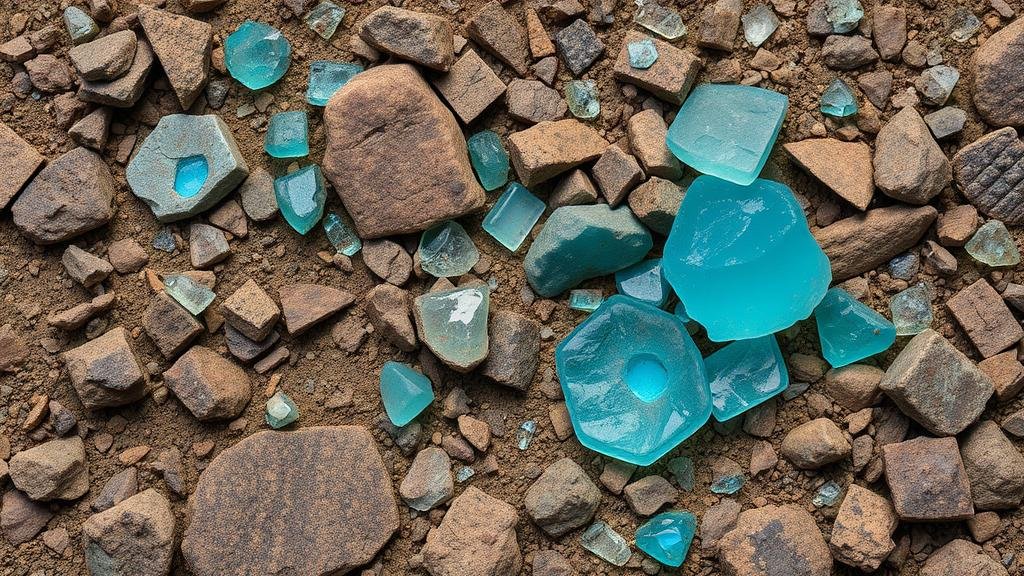Discovering turquoise-colored glass slag left behind by old smelting operations in historic mining districts.
Discovering Turquoise-Colored Glass Slag: A Hidden Treasure for Rockhounds
For rockhounds and mineral collectors, the thrill of discovery can manifest in many forms, particularly when exploring historic mining districts. One unique find that often captivates enthusiasts is turquoise-colored glass slag, a byproduct of ancient smelting operations. This article will delve into the origins of this remarkable material, where to find it, and why it should pique the interest of collectors.
The History Behind Glass Slag
Glass slag is a vitreous material formed primarily during smelting processes used to extract metals from ores. In many historic mining districts, particularly those associated with copper, lead, and zinc extraction, glass slag was a common byproduct. As these operations often reached their peak during the late 19th and early 20th centuries, remnants of their activity are scattered across various locations in the United States and around the world.
During the smelting process, impurities in the ore are separated from the desired metals. When heated to high temperatures (up to 1,600 degrees Celsius), silica and other minerals can melt and fuse together, creating a glassy substance. specific color of the slag, including the vibrant turquoise shades, is influenced by the chemicals present during the smelting process. For example, copper smelting tends to produce turquoise tones due to the presence of copper ions.
Identifying Turquoise Glass Slag
When hunting for glass slag, collectors should familiarize themselves with the characteristics that differentiate it from other types of mineral finds. Here are key identifiers:
- Color: The most sought-after characteristic is the rich turquoise hue, which can range from deep blue-green to lighter shades.
- Texture: Glass slag typically has a smooth, glossy surface. It may display an iridescent sheen when light hits it at the right angle.
- Weight: Compared to similarly sized stones, glass slag is surprisingly lightweight due to its glass composition.
- Form: Often found in rough shapes and fragments, slag can appear as chips or larger, rounded pieces.
Where to Find Turquoise Glass Slag
Rockhounds interested in adding turquoise glass slag to their collections should focus on areas with a rich mining history. Some notable locations include:
- Arizona: The state’s copper mines, especially around Bisbee, have yielded numerous examples of turquoise slag.
- Colorado: Historical mining towns such as Leadville and Central City often have slag heaps where collectors can search.
- California: Regions near the Sierra Nevada foothills, where mining for silver and gold occurred, also present opportunities for finding glass slag.
Its advisable to check local regulations regarding collecting in these areas, as some sites may be protected or private property.
Practical Tips for Collectors
For collectors looking to add turquoise glass slag to their assortment, consider these strategies:
- Research: Study the historical context of mining operations in your target area. Understanding the smelting processes can enhance your ability to identify slag and its origins.
- Join Local Groups: Engaging with local rockhounding clubs or online forums can provide valuable insights on potential locations and techniques for slag collection.
- Utility Tools: Bring tools such as a pick, shovel, and appropriate safety gear. A sifting screen can also help in locating smaller pieces of slag.
Also, its essential to respect the environment by following sustainable collecting practices, including leaving the area as you found it and adhering to the “Leave No Trace†principles.
The Value of Glass Slag
Beyond its aesthetic appeal, turquoise glass slag can hold significant value for collectors. Factors that contribute to its worth include:
- Rarity: The beauty and rarity of specific colors and patterns can significantly increase value.
- Historical Significance: Pieces from well-known historical mines may fetch higher prices among collectors.
Conclusion: A Unique Collectible
Turquoise-colored glass slag is more than just a colorful remnant; it is a connection to the history of mining operations and industrial processes that shaped many regions. As you embark on your collection journey, remember to appreciate the story each piece tells and the natural beauty encapsulated within its glassy surface. With the right approach, not only can you add a unique item to your collection, but you can also treasure the adventure of discovery that comes along with it.



